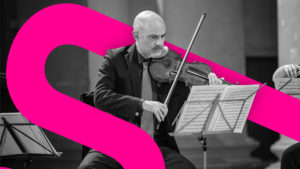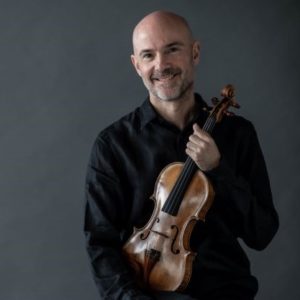
Flights of Fancy

Flights of Fancy
One of the best loved of all Vaughan Williams’ works, this glorious piece was first started in 1914. It took its inspiration from a poem of George Meredith, an extract from which is inscribed on the score.
He rises and begins to round
He drops the silver chain of sound,
Of many links without a break,
In chirrup, whistle, slur and shake….
For singing till his heaven fills,
‘Tis love of earth that he instills
And ever swinging up and up,
Our valley is his golden cup
And he the wine which overflows
To lift us with him as he goes…
Till lost on his aerial rings
In light, and then the fancy sings.
Vaughan Williams put the work to one side at the outbreak of war (in which he served with a military ambulance unit in France) but resumed work on it in 1920. The first performances were given by its dedicatee, Marie Hall, that for violin and piano at a concert of the Avonmouth and Shirehampton Choral Society on 15 December 1920, and that for violin and orchestra at the Queen’s Hall with the British Symphony Orchestra under Adrian Boult on 14 June 1921.
It is a meltingly beautiful piece, with instant appeal. (It achieved the ultimate accolade in 2008 when it was voted the nation’s favourite piece of music in Classic FM’s Hall of Fame…… ). The violin, depicting the lark, rises and soars aloft, wending its way through the sky in “rapt contemplation” and accompanied by quiet, hazy harmonies from the orchestra. There is a short, folk-song like middle section, though like many of VW’s “folk song” moments the music is the composer’s own. The soloist then again takes wing and eventually soars away, beyond our sight and hearing. The piece ends in an infinity of space, with the violin climbing ever higher until all sound ceases.
To many, this music typifies a vision of a beautiful English scene, a picture of a Cotswold landscape, with the idea of a lark somehow relating to the fields below and sharing “a love of earth” with the listener. Some, though, have heard sadness as well as joy in the music. It was originally composed, we remember, in 1914, the fateful year, and completed in 1920. It could be that the composer’s finished thoughts are reflecting on a way of life that could never quite return. Churches in villages all over England were erecting memorials to their young men, the loss of whom could be seen as hastening the end of the sort of rural life with its folksongs and other traditions that had held sway in the land for centuries. A celebration of the English countryside, indeed, but perhaps also an elegy for a lost England.
© Richard Butler
I Moderato
II Tempo di valse
III Scherzo: Vivace
IV Larghetto
V Finale: Allegro vivace
Antonín Dvořák was born into poverty in rural Bohemia, but was fortunate enough to be able to study in Prague. He developed into a good violist and played in the National Theatre orchestra under Bedrich Smetana, who exerted a strong influence on him. By 1873, Dvořák was making his living primarily as a teacher and composer. Grants from the Austrian government allowed him to concentrate more on composition, and he attracted the attention of Johannes Brahms, who arranged for the publication of his works by Simrock, one of the major European publishers.
Dvořák wrote his ravishing Serenade in E in May 1875. The model of the serenade had been set at the end of the previous century in Mozart’s many examples of the form: a serenade would typically open with a march, include a sonata movement, a selection of slow movements and minuets, and close with a fast finale. By Dvořák’s time the form had left behind its specific connotation as entertainment music for special occasions, and become a concert piece for a larger body of instruments (a full complement of strings, for example) but the loose collection of movements and the generally light tone were preserved.
Dvořák was a great master of melody, and that fact is amply demonstrated in this work, which is one of his earliest true masterpieces. The first of the five movements is a leisurely Moderato that sets the scene for this relaxed and good-natured score. The middle section is a little more playful, even coquettish, but the mood is not substantively different from the first subject, which returns and leads to a gentle conclusion. For the second movement, Dvořák offers up a Tempo di Valse in C sharp minor, but there is nothing of grief or tragedy here. The nature of the music belies the sombre key signature. The tempo and manner are so easygoing as to suggest more a promenade, or even a dream, than a waltz. There is only one brief outburst of vigour towards the end of the central section.
The pace picks up markedly in the third movement, a frothy fast Scherzo marked Vivace. This is all sunshine and jollity, with rapid figurations livening things up. Yet a return to a more sedate tempo seems an entirely natural outgrowth of all this energy and for a time we are back in the world of the first movement. There are a couple of minor key episodes (treatments of the Vivace idea), but these cast only light and fleeting shadows before moving on, and once again we seem to be enjoying that untroubled walk in the park. This movement, like the previous two and the following Larghetto, is in ternary form, so the animated material comes back at the end. Next Dvořák proves that he can write a gorgeous slow movement with the best of them. Solo players emerge from the mass of strings from time to time to add their more intimate comments.
The finale, Allegro vivace, starts with a rather dramatic declamation, but the main quality of this movement is airy and mercurial. Towards the end of the exposition, the Larghetto theme is quoted, and just before the end of the recapitulation – and of the movement and the piece as a whole – there is a longer quotation taken directly from the opening Moderato. But bustling energy is king here, and the excitement that holds sway through most of the movement also brings it to its blithe conclusion.
© Elizabeth Boulton
In Winter’s House by Joanna Marsh, originally a choral setting of a poem by Oxford-based poet Jane Draycott, has been reimagined for strings alone by Julian Azkoul. Initially commissioned for the tenors and basses of Tenebrae, the piece was premiered at Wigmore Hall on December 1st, 2019, fittingly situated within a program reflecting on the summer and winter solstices. There are many works for instruments that have been given words and then recreated for choir, but fewer the other way around. This is usually because the words play an important part in giving meaning to the music, with text influencing the structure. The music captures the fairy-tale landscape evoked by the interplay of darkness and light, renewal and rebirth so the essence of Jane Draycott’s poetic imagery is retained.
© Joanna Marsh
Samuel Coleridge-Taylor was just 27 when he completed his Four Novelletten (two of which you hear in this performance) in 1902, though he would die only a decade later from pneumonia. Nonetheless, he was a widely celebrated figure in his lifetime. Born in London to an English mother and a father from Sierra Leone, he gained his unusual name because of his mother’s love for the poetry of Samuel Taylor Coleridge, and entered the Royal College of Music at the age of just 15, where he studied composition under Stanford. He was greatly admired by Elgar, and celebrated by Elgar’s editor August Jaeger (immortalised as ‘Nimrod’ in Elgar’s Enigma Variations), who called Coleridge-Taylor ‘a genius’. His huge trilogy of cantatas The Song of Hiawatha packed out the Royal Albert Hall for ten seasons in extravagant ballet versions conducted by Malcolm Sargent, though Coleridge-Taylor suffered, too, from significant racial discrimination, and his music was allowed to slip quietly from public consciousness after his death. It’s only in far more recent years that it’s undergone a major reappraisal.
His Novelletten may have been inspired by Schumann’s piano miniatures of the same name, but they were surely influenced, too, by Coleridge-Taylor’s own prowess as a concert violinist, expertise that he puts to good use in No. 3. The pieces’ lyrical, somewhat sentimental style nonetheless conceals quite a remarkable exploration of the sonic possibilities of a string orchestra, to which Coleridge-Taylor adds a tambourine and triangle. These contribute greatly to the Spanish-sounding exoticism of No. 1’s opening, before the piece moves on to an elegant, soaring melody for violins, and a lighter central section with a flavour of Mendelssohn’s fairy music about it. Though titled ‘Valse’, No. 3 feels rather too slow to be danced to. It features a solo violin from the start, whose lofty melody slowly drifts back down to earth, and, following a livelier, brighter central section, returns to bring the piece to a wistful close.
© David Kettle
Violin 1
Simon Blendis
Jessica Coleman
Martin Smith
Nicola Gleed
Daniel Stroud
Magdalena Loth-Hill
Violin 2
Tristan Gurney
Anna de Bruin
Rebecca Bell
Juan Gonzalez
Lyrit Milgram
Viola
Judith Busbridge
Christine Anderson
Oliver Wilson
Christopher Beckett
Cello
Sebastian Comberti
Sarah Butcher
Miriam Lowbury
Double Bass
Benjamin Russell
Lucy Shaw
CHIEF EXECUTIVE
Flynn Le Brocq
CONCERTS
Projects Director Sophie Haynes
Orchestra Manager & Fixer Jason Weir
Artistic Projects Coordinator Alex Mackinder
DEVELOPMENT
Development Manager Tristen Hennigs
Fundraising & Operations Peter Wright
Fundraising Consultant Paul Hudson
Outreach & Evaluation Consultant Bec Britain
Honorary Chair – Friends of LMP Christine Robson
MARKETING
Senior Marketing & PR Manager Anna Bennett
Marketing and Development Coordinator Bethany Penny
Digital Marketing Manager Charles Lewis
EVENTS
Royal Event Manager Rachel Rae
Freelance Events Producer Sophie Branscombe
FINANCE
Bookkeeper Debbie Charles
Leader Debbie Beckerman & Keith Jones
Leader Sophie and Jeffrey Prett
Co-Leader Michael Southwell
Violin 1.3 Liz and Alistair Milliken
Violin 1.4 currently not sponsored
Violin 1.5 Christine Robson
Violin 1.6 Della Brotherston
Violin 1.7 currently not sponsored
Violin 1.8 currently not sponsored
Violin 1.9 currently not sponsored
Associate First Violin currently not sponsored
Principal Second Violin Barbara Maw
Violin 2.2 The Angel Family
Violin 2.3 Mia and Keith Ball
Violin 2.4 Alastair Fraser
Violin 2.5 currently not sponsored
Violin 2.6 Catherine Shaw – Allbone and Trimit
Associate Second Violin currently not sponsored
Principal Viola Mark and Vanessa Petterson
Co-Principal Viola Stanley Slaughter & Linda Davidson
Viola 3 Gill Cox
Viola 4 currently not sponsored
Associate Viola currently not sponsored
Principal Cello Anonymous
Sub-Principal Cello Leslie Aarons
Cello 3 Gillian Noble
Cello 4 currently not sponsored
Associate Cello Colin and Helen Snart
Associate Cello
Principal Double Bass John Clarke
Co-Principal Double Bass The Bristow Family
Principal Flute currently not sponsored
Sub-Principal Flute Raymond Calcraft
Principal Oboe Pat Sandry
Co-Principal Oboe currently not sponsored
Sub-Principal Oboe currently not sponsored
Principal Clarinet Deirdre Lea
Sub-Principal Clarinet Graham Harman
Principal Bassoon currently not sponsored
Sub Principal-Bassoon Barbara Tower
Principal Horn currently not sponsored
Sub-Principal Horn Chris Harman
Principal Trumpet Ishani Bhoola
Sub-Principal Trumpet Cynthia Harrod-Eagles
Principal Trombone currently not sponsored
Sub-Principal Trombone currently not sponsored
Principal Bass Trombone currently not sponsored
Principal Timpani Cynthia Harrod-Eagles
Principal Percussion currently not sponsored

A Place in Time
Friday 30 May 2025
St. Martin-In-The-Fields
Full of memorable tunes and toe-tapping dances, the electrifying saxophonist Jess Gillam brings the heart and soul of folk-inspired music to life in this concert.
Simon Blendis
violin/director

Simon joined LMP as leader in 2014. He was a member of the Schubert Ensemble for twenty-three years, from 1995 until the group retired in 2018, leaving a legacy of over 80 commissions, 25 CD recordings and a large library of live performances on YouTube.
Simon is in demand as a guest-leader and has appeared in this role with most of the UK‘s major orchestras. He has also appeared as a guest-director with orchestras such as the Academy of St. Martin-in-the-Fields, the English Chamber Orchestra, the Amsterdam Sinfonietta and the Scottish Ensemble. Since 1999 he has shared the position of leader of Orchestra Ensemble Kanazawa in Japan, with whom he has recorded Vivaldi‘s Four Seasons for the Warner label. As a soloist he has appeared with orchestras including the Philharmonia Orchestra, the RPO and the CBSO.
During the Coronavirus lockdowns Simon spent time researching the light music legacy of legendary violinist Max Jaffa. The resulting CD of 25 lost or forgotten gems from this archive, entitled Love is Like a Violin, was released in July 2022 to critical acclaim, and has already garnered over 4 million streams.
Increasingly sought after as a teacher, Simon is a professor of violin at the Guildhall School of Music and Drama.
